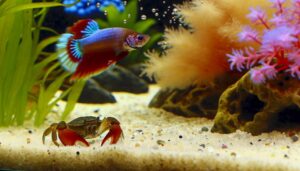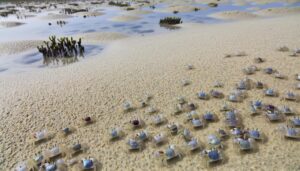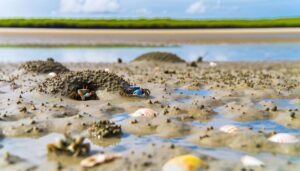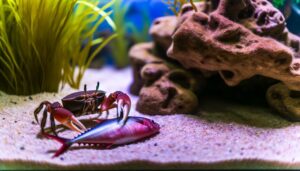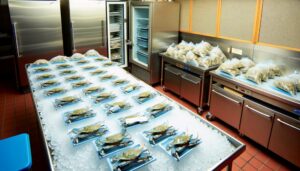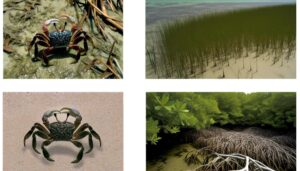How Do Cats Eat Hermit Crabs Safely?
Yes, when you cook blue crabs, they turn red. This happens because heat denatures the protein complex called crustacyanin that binds with the blue astaxanthin pigment in their exoskeleton.
At temperatures above 100°C (212°F), this denaturation process frees the red astaxanthin pigment. This color change is a result of the thermal disruption of protein-bound carotenoids, similar to what occurs in other crustaceans like lobsters and shrimp.
Understanding the role of heat in this molecular transformation provides insights into both culinary and scientific aspects of crab pigmentation. Interested in the finer scientific details?
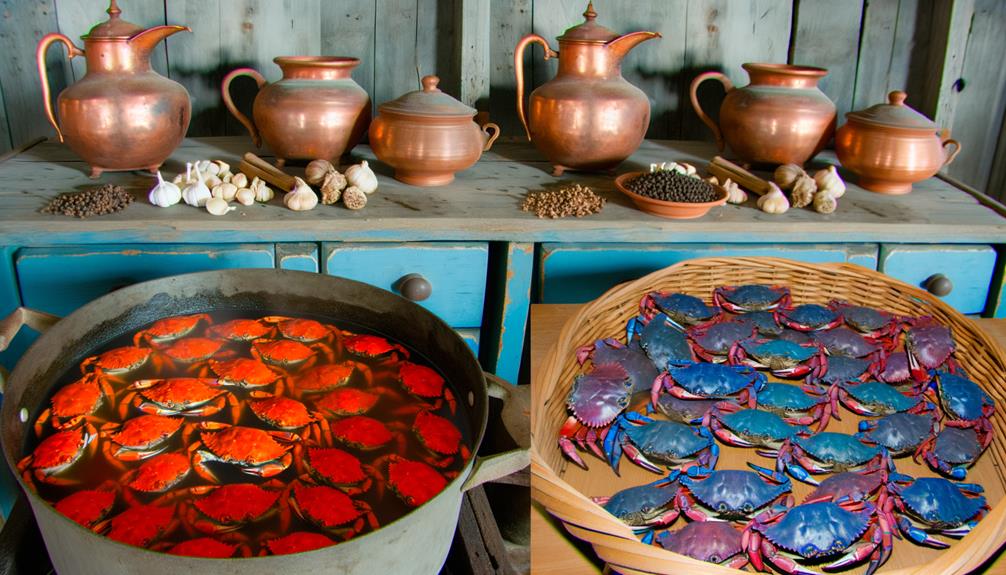
Key Takeaways
- Heat denatures the crustacyanin complex in blue crabs, releasing the red astaxanthin pigment.
- Cooking temperatures above 100°C (212°F) initiate the color transformation in blue crabs.
- The red coloration is due to the freed astaxanthin pigment when proteins are denatured by heat.
- Carotenoids in the crabs' exoskeleton change structure, leading to the red hue when cooked.
- Similar color changes occur in other crustaceans like lobsters and shrimp due to heat exposure.
The Science of Crab Pigments
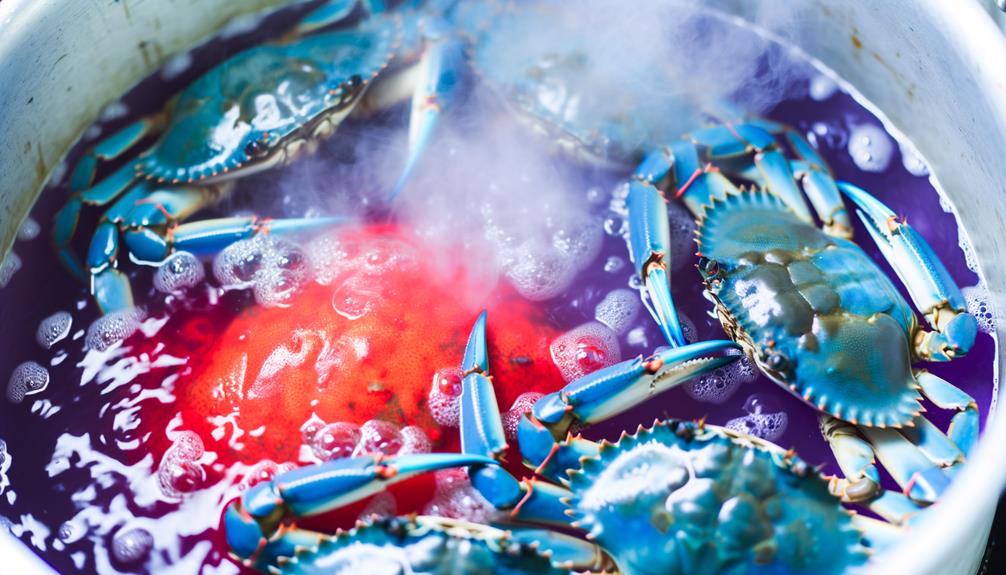
Understanding why blue crabs turn red when cooked involves examining the molecular structure and behavior of their pigments. Blue crabs possess a pigment called astaxanthin, which is bound to proteins in their exoskeleton, creating a blue-green coloration.
This pigment-protein complex, known as crustacyanin, stabilizes the blue hue by altering astaxanthin's light absorption properties. When you analyze the data, you'll find that crustacyanin binds tightly to astaxanthin, changing its optical characteristics. However, the stability of this complex is sensitive to external factors.
Role of Heat in Color Change
When subjected to heat, the crustacyanin complex denatures, releasing the astaxanthin pigment and resulting in the blue crab's red coloration.
You'll observe this transformation because the heat causes the protein-bound carotenoids to lose their conformational structure.
This denaturation process frees the astaxanthin, which is naturally red.
Scientific data confirms that temperatures above 100°C (212°F) are sufficient to initiate this change.
Carotenoids Explained
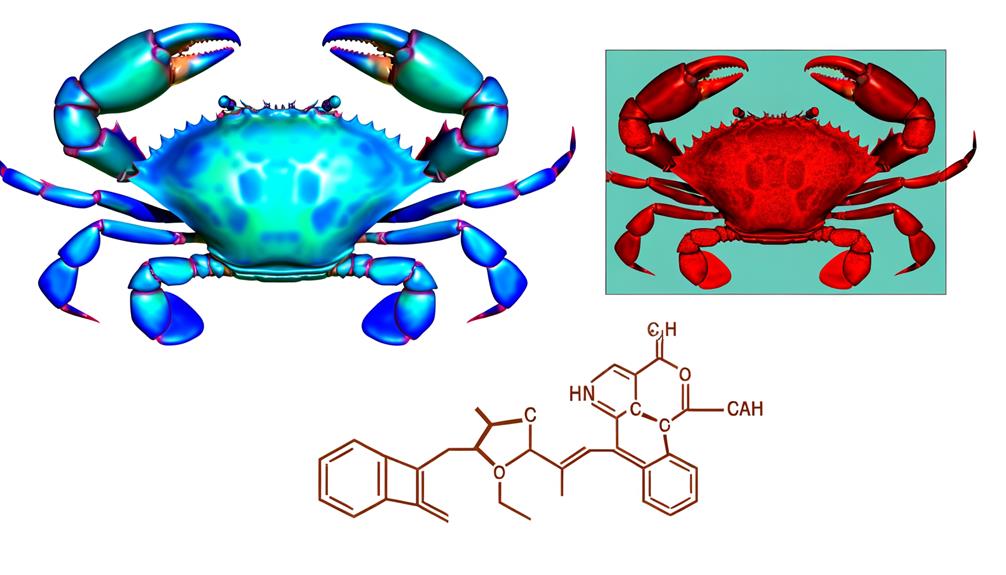
Carotenoids, a class of pigments found in marine life, play an essential role in the vibrant coloration of blue crabs. These organic pigments are synthesized by plants and algae, subsequently accumulating in marine organisms through their diets. You can understand carotenoids better with the following data:
| Carotenoid Type | Natural Source |
|---|---|
| Astaxanthin | Microalgae, Krill |
| Beta-carotene | Algae, Phytoplankton |
| Lutein | Algae, Seaweeds |
| Zeaxanthin | Marine Algae |
| Lycopene | Red Algae |
Carotenoids are hydrophobic molecules, integrating into cell membranes and contributing to the blue-green hue of live crabs. When you cook blue crabs, these pigments undergo structural changes, resulting in the red coloration, a fascinating transformation driven by heat. Understanding carotenoids enriches your knowledge of marine biology and culinary science.
Interaction With Proteins
When you cook blue crabs, heat causes protein denaturation, disrupting the bonds that hold the proteins' structures together. This process releases astaxanthin pigments, which are originally bound to proteins, leading to the characteristic red coloration.
Temperature data indicates that this pigment transformation typically occurs around 100°C (212°F).
Heat and Protein Denaturation
Upon exposure to heat, the proteins in blue crabs undergo denaturation, disrupting their native structures and leading to visible color changes.
When you cook them, the elevated temperatures alter the tertiary and quaternary structures of the proteins. Specifically, heat breaks the hydrogen bonds and disulfide bridges that maintain the proteins' functional conformations. This denaturation process doesn't just affect the overall texture but also the appearance.
For instance, myofibrillar proteins in the muscle fibers coagulate, making the flesh more opaque and firm. Additionally, the heat-induced denaturation alters other structural proteins, causing a shift in the crab's color.
These structural changes are essential for achieving the desired culinary texture and visual appeal, providing a scientific basis for why blue crabs turn red.
Pigment Transformation Process
As the proteins denature, the pigment transformation process begins, where the heat exposure releases astaxanthin from its protein complexes, causing the blue crabs to turn red.
This phenomenon occurs due to the breakdown of crustacyanin, the protein complex binding the blue pigment to astaxanthin. When exposed to temperatures above 100°C, the protein structure unfolds, liberating astaxanthin, which exhibits a vibrant red hue.
This transformation isn't merely aesthetic but a chemical rearrangement driven by thermal denaturation. You'll observe this color change consistently, as it's a predictable outcome of the cooking process.
Comparing to Other Crustaceans
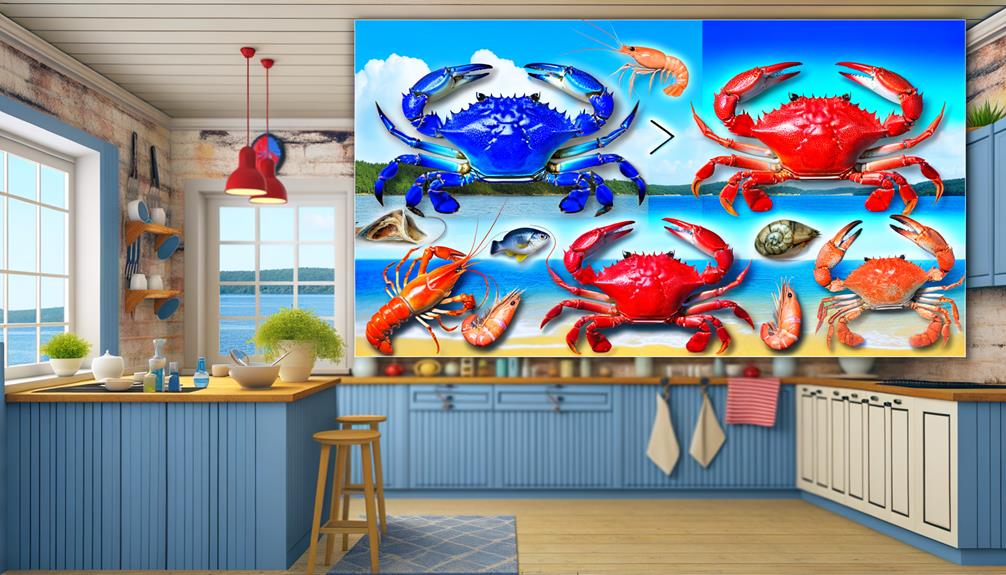
Blue crabs' color-changing phenomenon when cooked isn't unique; similar transformations occur in lobsters, shrimp, and other crustaceans due to the breakdown of the pigment complex astaxanthin.
When you cook these crustaceans, heat denatures the protein crustacyanin, which usually keeps astaxanthin in a bound state, masking its red color. In lobsters, for instance, denaturation occurs around 100 degrees Celsius, releasing astaxanthin and revealing the red hue.
Shrimp exhibit a comparable process, with thermal exposure leading to a vivid color shift. This biochemical reaction is consistent across various species, highlighting a common evolutionary adaptation.
Culinary Implications
When cooking blue crabs, the transformation to a vibrant red not only signals doneness but also enhances their visual appeal, impacting both presentation and perceived flavor. The red coloration results from heat-induced denaturation of proteins, specifically crustacyanin, which releases astaxanthin pigments.
For best culinary outcomes, consider these factors:
- Cooking Time: Make sure crabs are cooked for the precise duration to achieve the ideal texture and color.
- Presentation: The striking red color can elevate your dish's visual appeal, making it more appealing to diners.
- Flavor Perception: The color change can psychologically impact how flavors are perceived, potentially enhancing the dining experience.
Conclusion
When you cook blue crabs, they turn red due to carotenoids like astaxanthin, previously bound to proteins. Heat breaks these bonds, revealing the vibrant red akin to a sunset.
This pigment shift is common in crustaceans, highlighting nature's intricate chemistry.
Understanding this process isn't just culinary; it's a nod to the profound interplay between biology and cooking, akin to alchemy.
So, next time you boil crabs, remember, it's science turning them red.

